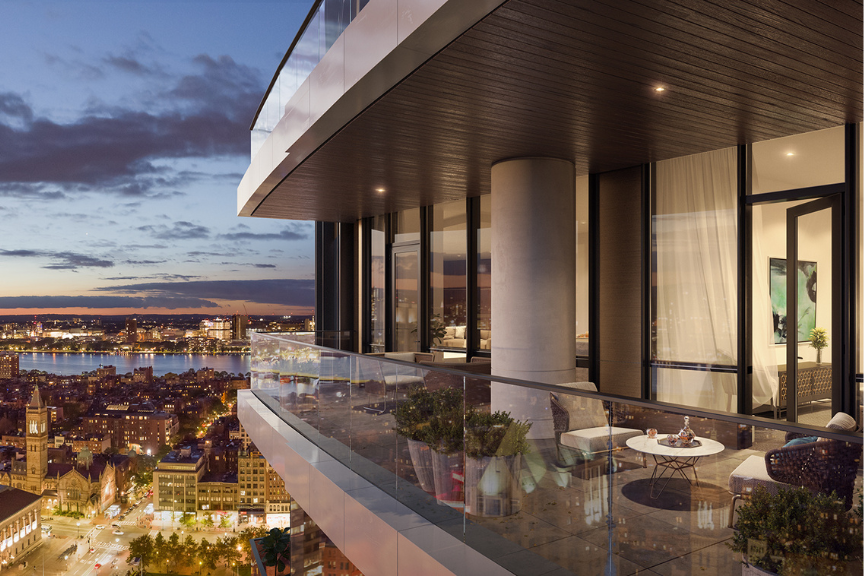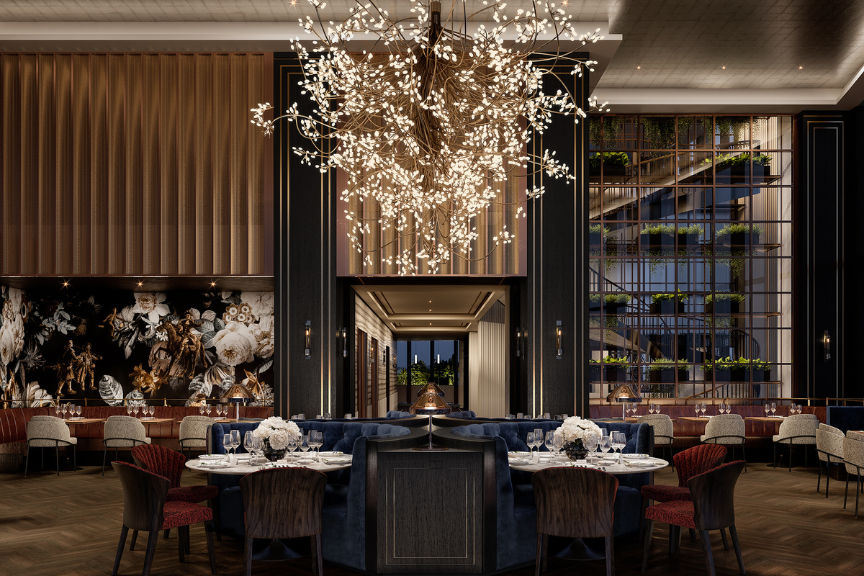At the high end, for-sale and rental multifamily luxury housing delivers the crème de la crème in technology, concierge-style services and amenities.
In many metros and suburban markets, luxury living means for-sale apartments that start at $1 million and rentals that are also uber-expensive. One recent for-sale listing in Boston’s chic Back Bay neighborhood was listed at almost $6 million; a San Francisco Pacific Heights rental was marketed at $10,000 a month.
Luxury doesn’t merely equate to dollars spent, though. There’s also a perception that a building, and what’s inside it, offers its occupants the best, says Mary Cook of commercial interiors design firm Mary Cook Associates, which collaborates with home builders.
Today, there’s another challenge for those working in this niche, says Cook. “There’s a greater tug of war between what goes into the units and amenity spaces because of the cost of building Class A structures. Costs for materials, labor, land and services are all rising,” she says, adding, “Everybody wants the best, and choices often depend on the demographic’s values and the project’s location.” In Salt Lake City, where outdoor activities are plentiful, a gear closet for ski and board storage is important. In a downtown site, a spacious roof deck with outdoor space, plantings and stunning views could add more value, Cook says.
Those developing and designing properties at the high end plan their budgets, too, to appeal to this demographic, says architect Michael E. Liu, senior partner and design principal at architecture firm The Architectural Team (TAT).
Luxury owners and renters aren’t the only beneficiaries. Many choices eventually trickle down and become more widespread and affordable for a larger pool of residents. Following are seven categories that set luxury buildings apart.
Location
Location still ranks high in the luxury space. Safety, walkability, access to greenery and superior views top the location list, says Ximena Rodriguez, principal and director of interior design at CetraRuddy in New York City. The 200 Amsterdam Avenue condominium building there, for which her firm served as interior designer, offers luxury in its proximity to Lincoln Center’s cultural offerings and Central Park.
Prize locations are also emphasized through materials, scale, detailing and fenestration, says architect John W. Schenck AIA, LEED AP of Svigals + Partners, in New Haven, Conn. The site for The Mark rental building designed by architecture firm AO plays up the historic district of Riverside, Calif., by showcasing views of the iconic Fox Theater and Mission Inn, says firm architect Michael Heinrich, AIA, Principal. Its stepped-back facade adds its own visual imprint to the streetscape. In downtown Philadelphia, Dranoff Properties’ Arthaus condominium building offers walkability in the arts district.
Suburbs have prime locations, too. The Finger Companies’ new The Quin rental building in Schaumburg, Ill., outside Chicago, is close to many corporate headquarters, a Topgolf entertainment venue, and highways to downtown and to O’Hare International Airport.
Residents will pay a premium for a desirable location, says Dan Doyle, senior vice president and COO at The Beach Company in Charleston, S.C. His company’s 12-story rental The Jasper in that city’s downtown offers panoramic water views and sits adjacent to a park and playground. “It’s the gateway to the historic district,” he says.
Size and Square Footage
The scale and square footage of areas from the shared spaces to the individual units can also convey a feeling of luxury, Rodriguez says. Some larger, detailed buildings stand out in their neighborhood or skyline, she says. Robert A.M. Stern Architect’s 15 Central Park West building in Manhattan has a recognizable classic limestone facade and canopied bronze entry door that mirrors the class of nearby older buildings. In Charleston, a city known for historic preservation, The Jasper’s facade mimics Old World wealth with 1,600 precast panels that use concrete clad with thin brick. Optima Verdana, a 100-unit, six-story building designed, developed and managed by Optima Inc. that opens soon in the Chicago suburb of Wilmette, Ill., presents spacious layouts and features similar to those of a custom single-family home.
Materials
Configuration and aesthetic are as important as the materials themselves. “It might be the way a beautiful marble is installed, a special glass is used in cabinets or an island is constructed,” says Rodriguez.
Sustainability and wellness have become more important, with choices veering toward low-volatility paints and carpeting, FSC-certified woods, and LED lighting and controls. Dranoff’s Arthaus is said to be Philadelphia’s first biophilic development, with personal garden plots and a professional greenhouse. The Jasper emphasizes big windows and natural light. If there’s a common denominator in what luxury looks like, it’s cleaner, lighter and without a Mediterranean edge, says real estate salesperson Kevin Spina of Keyes Real Estate in Palm Beach Gardens, Fla.
Amenities
Over the past five to 10 years, lines have blurred between amenities at the for-sale and rental luxury levels, says Liu. As with a single-family home, curb appeal starts at the sidewalk, with features like upscale landscaping, lighting and walkways, and continues through the lobby and shared spaces and up to the terraces and rooftops.
The most luxe shared spaces also incorporate the latest trends borrowed from hotels and resorts, such as wine and liquor cabinets, beehives and edible gardens.
Workspaces are available in units and also in amenity rooms, where luxury finishes and office perks like coffee bars and plush furnishings are available, says designer Carrie Tolman, associate principal with Chicago architecture firm KTGY’s interior design studio. Some buildings allow residents to purchase cabanas for privacy, says Spina. At The Quin, residents can rent furnished guest suites, so their guests enjoy privacy, says Hunter Wagner, The Finger Companies’ executive vice president of asset management.
Because of today’s emphasis on healthfulness, activities abound: Squash, basketball, pickleball, indoor and outdoor pools, and golf simulators are favorites. At The Quin, a gated 2 1/2-acre park has lighted walking trails, benches, picnic tables, two dog parks and native trees and specimen plantings. And gardens also aid healthy outlooks and bodies. Optima Verdana, in Wilmette, includes exterior hanging gardens designed to remain green year-round in its four-season surroundings.
Some buildings, particularly in South Florida, focus on kids through themed play and learning rooms, toddler splash pads, over-the-top playgrounds, miniature golf courses, sports courts and outdoor theaters. Miami’s One Park Tower by Turnberry features a crystal clear 7-acre lagoon.
More buildings are also incorporating food and dining options, through a hotel dining room or restaurant or a convenience store, often with healthy options, says designer Katherine Berger, Director of Design at Svigals + Partners. Many terraces and rooftops also have top-notch kitchen equipment that mirrors quality indoor appliances and allows residents to be their own chef.
The best of technology is a must-have as well, with strong bandwidth and smart-home features that residents can control from their mobile devices. Many buildings have added customized apps to track deliveries, schedule repairs and communicate with staff or other residents, says Doyle.
Unit Features
Luxuries show up in handcrafted materials, extra-high ceilings, oversized windows, bigger glass walls to the outside, the best kitchen and bathroom appliances and fixtures, water conservation and energy efficiency considerations, multiple fireplaces and balconies, detailed moldings and trims, and oversized closets. But owners prefer to outfit closets themselves, says Alexander Donovan, senior project manager at TAT. Anything that can be done to decrease upkeep gains favor, like The Jasper’s use of wood or luxury vinyl planking rather than carpet.
Some developers, like Harvey Hernandez, founder and CEO of Newgard Development Group, fully furnish units as a luxury perk. The company’s Lofty Brickell in Miami is furnished with Italian mattresses and German appliances, he says. If buyers want to make selections, they can receive a furniture credit, he adds. Of the building’s 362 condos, 92% have been presold.
Services and Programs
Services and programs are also borrowed from the hospitality sector as more condos and rentals are constructed within hotels. Raffles Residences in Boston, designed by TAT, is one example. Other names that convey status in the luxury residential niche include the Baccarat Residences, Casa Bella Residences by B&B Italia, Waldorf Astoria, the Ritz-Carlton, the Standard Residences and Aston Martin Residences.
Service may come from the equivalent of a concierge or doorperson who walks a resident’s dog, delivers dinner or parks a car. At The Jasper, two concierges plan events such as bourbon tastings, says Doyle. Other specialists on staff or contract provide massages, pedicures, manicures and fitness training in a home, says Tolman, whose firm recently completed renovations at the Waldorf Astoria Chicago.
The goal, Rodriguez says, is to make life easier. To follow that, staff at Houston-based Venterra Realty’s rental properties will hang a TV and perform other handyman services gratis, says Richard Roos, chief operating officer.
Quality Control
Updates are critical to maintain luxury. At The Beach Company’s buildings, that means painting, wallpapering and laying new carpeting or flooring every two to five years, or as needed. At its 2-year old The Jasper, the company is refreshing pool deck furniture. “We’re in a harsh climate and people use the facility,” Doyle says.









